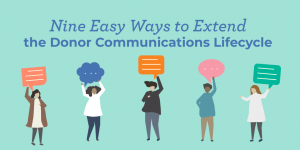Your nonprofit is probably starting to think about how to get a strong start to the new year. We’re almost through the year-end fundraising craziness. And January and February are the perfect months to run a lapsed donor campaign to recapture your LYBUNTs.
LYBUNTs, or donors who gave “Last Year but Unfortunately Not This year” are not a lost cause.
Many factors can account for a lapsed gift. And not all of them are within your control. So, don’t assume a LYBUNT is no longer interested in helping your nonprofit reach its goals!
So, here’s what you need to know before you reach out to these donors, open a dialogue, and encourage them to help your organization achieve its mission once again.
Who are your LYBUNTs?
According to the Fundraising Effectiveness Project, new donor retention rate has dropped by 17.5 percent year-over-year. So, keep this in mind when you are combing through your donor database. You can drastically increase your conversion rate by focusing on LYBUNTs who have made more than one past gift to your organization.
Once you have determined which LYBUNTs are most likely to give again, pull any relevant data about them. Information about past gift amounts, donation frequency, and what programs they supported are particularly important. If possible, determine why they haven’t made their usual contribution to your organization.
READ MORE: Applying data-driven ask strings in your appeals.

What are they hearing?
While digging for information, determine the last several communications each LYBUNT donor received. It should be a huge red flag if they’ve been receiving appeal after appeal without many other touches in between.
As you know, donor fatigue is a real concern. Fundraising organizations must vary their messages and reach out with different types of communications, aside from appeals, to retain donors long-term.
So, look for ways to add extra touches to your communications pipeline.
For example, let’s say the last time a donor heard from you was when you invited them to your annual awards dinner. They didn’t attend, and that’s OK! What’s not OK is if they don’t hear from you for months after, and then you hit them with an appeal.
Consider sending a newsletter about the event before sending another appeal. Highlight award winners and other important moments from the night they would not have known about to keep your donors in the loop.
The worst thing an organization can do is make their donors feel like a source of income.

Express your gratitude.
When a new or repeat donor makes a gift, we know we need to thank them promptly. However, one of the reasons your donor retention rate may suffer is because your “thank you’s” don’t do much other than say, “thanks!”
If someone holds the door open for you, a simple “thanks” will suffice. But you need to do more when someone opens their wallet or volunteers their time to help you advance your mission.
Let your donors know exactly how their gift will be used to make the world a better place.
Include pictures of the people that you help and invite them to participate in volunteer opportunities to continue their support.
And don’t forget to send a handwritten note or pick up the phone and have a conversation with major donors after they make a gift. You want to find out what exactly about your mission inspired them to give and what might encourage others to continue their support.
READ MORE: Can your nonprofit send better thank you’s?

Run a LYBUNT appeal campaign.
If you put in all this work and then reach out to your LYBUNTs with the same appeal you send all your current donors, you’ve missed a great opportunity!
Fundraisers build donor personas and profiles because no two donors are the same. While personalization strategies can help make appeals feel relevant and specific for individuals, you need to segment your audience to ensure they receive the message that applies to them.
Then, discuss how renewing their gift today would impact your goals. To add that personal touch, you can use variable content to specify the date or dollar amount of past gifts for each donor.
But a word of warning! Be gentle with your LYBUNTs.
The point here is not to make them feel guilty for not giving to your organization. Instead, you want to nurture the relationship you have with them. Think about this appeal as reaching out to an old friend to catch up over a cup of coffee, not begging an ex-lover to give you another chance!
READ MORE: Key steps for recovering lapsed donors.
Retention is key.
How much time does your organization devote to retaining lapsed donors compared to acquiring new ones? If too much of your energy is spent finding new donors and securing first-time or one-time gifts, you might do more harm than good.
Don’t forget, it can cost your nonprofit 50 to 100 percent more to acquire a new donor than you will receive from their first gift!
If you want to raise more money this year, shift some of your focus away from acquiring new donors and really work on convincing your LYBUNT donors to give again.
Click here to chat about how to engage your LYBUNTs with our team!









